Zhiyang He
MedFact: Benchmarking the Fact-Checking Capabilities of Large Language Models on Chinese Medical Texts
Sep 15, 2025Abstract:The increasing deployment of Large Language Models (LLMs) in healthcare necessitates a rigorous evaluation of their factual reliability. However, existing benchmarks are often limited by narrow domains of data, failing to capture the complexity of real-world medical information. To address this critical gap, we introduce MedFact, a new and challenging benchmark for Chinese medical fact-checking. MedFact comprises 2,116 expert-annotated instances curated from diverse real-world texts, spanning 13 medical specialties, 8 fine-grained error types, 4 writing styles, and multiple difficulty levels. Its construction employs a hybrid AI-human framework where iterative expert feedback refines an AI-driven, multi-criteria filtering process, ensuring both high data quality and difficulty. We conduct a comprehensive evaluation of 20 leading LLMs, benchmarking their performance on veracity classification and error localization against a human expert baseline. Our results reveal that while models can often determine if a text contains an error, precisely localizing it remains a substantial challenge, with even top-performing models falling short of human performance. Furthermore, our analysis uncovers a frequent ``over-criticism'' phenomenon, a tendency for models to misidentify correct information as erroneous, which is exacerbated by advanced reasoning techniques such as multi-agent collaboration and inference-time scaling. By highlighting these critical challenges for deploying LLMs in medical applications, MedFact provides a robust resource to drive the development of more factually reliable and medically aware models.
SimCroP: Radiograph Representation Learning with Similarity-driven Cross-granularity Pre-training
Sep 10, 2025Abstract:Medical vision-language pre-training shows great potential in learning representative features from massive paired radiographs and reports. However, in computed tomography (CT) scans, the distribution of lesions which contain intricate structures is characterized by spatial sparsity. Besides, the complex and implicit relationships between different pathological descriptions in each sentence of the report and their corresponding sub-regions in radiographs pose additional challenges. In this paper, we propose a Similarity-Driven Cross-Granularity Pre-training (SimCroP) framework on chest CTs, which combines similarity-driven alignment and cross-granularity fusion to improve radiograph interpretation. We first leverage multi-modal masked modeling to optimize the encoder for understanding precise low-level semantics from radiographs. Then, similarity-driven alignment is designed to pre-train the encoder to adaptively select and align the correct patches corresponding to each sentence in reports. The cross-granularity fusion module integrates multimodal information across instance level and word-patch level, which helps the model better capture key pathology structures in sparse radiographs, resulting in improved performance for multi-scale downstream tasks. SimCroP is pre-trained on a large-scale paired CT-reports dataset and validated on image classification and segmentation tasks across five public datasets. Experimental results demonstrate that SimCroP outperforms both cutting-edge medical self-supervised learning methods and medical vision-language pre-training methods. Codes and models are available at https://github.com/ToniChopp/SimCroP.
MVP-CBM:Multi-layer Visual Preference-enhanced Concept Bottleneck Model for Explainable Medical Image Classification
Jun 14, 2025Abstract:The concept bottleneck model (CBM), as a technique improving interpretability via linking predictions to human-understandable concepts, makes high-risk and life-critical medical image classification credible. Typically, existing CBM methods associate the final layer of visual encoders with concepts to explain the model's predictions. However, we empirically discover the phenomenon of concept preference variation, that is, the concepts are preferably associated with the features at different layers than those only at the final layer; yet a blind last-layer-based association neglects such a preference variation and thus weakens the accurate correspondences between features and concepts, impairing model interpretability. To address this issue, we propose a novel Multi-layer Visual Preference-enhanced Concept Bottleneck Model (MVP-CBM), which comprises two key novel modules: (1) intra-layer concept preference modeling, which captures the preferred association of different concepts with features at various visual layers, and (2) multi-layer concept sparse activation fusion, which sparsely aggregates concept activations from multiple layers to enhance performance. Thus, by explicitly modeling concept preferences, MVP-CBM can comprehensively leverage multi-layer visual information to provide a more nuanced and accurate explanation of model decisions. Extensive experiments on several public medical classification benchmarks demonstrate that MVP-CBM achieves state-of-the-art accuracy and interoperability, verifying its superiority. Code is available at https://github.com/wcj6/MVP-CBM.
* 7 pages, 6 figures,
EMRModel: A Large Language Model for Extracting Medical Consultation Dialogues into Structured Medical Records
Apr 23, 2025Abstract:Medical consultation dialogues contain critical clinical information, yet their unstructured nature hinders effective utilization in diagnosis and treatment. Traditional methods, relying on rule-based or shallow machine learning techniques, struggle to capture deep and implicit semantics. Recently, large pre-trained language models and Low-Rank Adaptation (LoRA), a lightweight fine-tuning method, have shown promise for structured information extraction. We propose EMRModel, a novel approach that integrates LoRA-based fine-tuning with code-style prompt design, aiming to efficiently convert medical consultation dialogues into structured electronic medical records (EMRs). Additionally, we construct a high-quality, realistically grounded dataset of medical consultation dialogues with detailed annotations. Furthermore, we introduce a fine-grained evaluation benchmark for medical consultation information extraction and provide a systematic evaluation methodology, advancing the optimization of medical natural language processing (NLP) models. Experimental results show EMRModel achieves an F1 score of 88.1%, improving by49.5% over standard pre-trained models. Compared to traditional LoRA fine-tuning methods, our model shows superior performance, highlighting its effectiveness in structured medical record extraction tasks.
Bridged Semantic Alignment for Zero-shot 3D Medical Image Diagnosis
Jan 07, 2025Abstract:3D medical images such as Computed tomography (CT) are widely used in clinical practice, offering a great potential for automatic diagnosis. Supervised learning-based approaches have achieved significant progress but rely heavily on extensive manual annotations, limited by the availability of training data and the diversity of abnormality types. Vision-language alignment (VLA) offers a promising alternative by enabling zero-shot learning without additional annotations. However, we empirically discover that the visual and textural embeddings after alignment endeavors from existing VLA methods form two well-separated clusters, presenting a wide gap to be bridged. To bridge this gap, we propose a Bridged Semantic Alignment (BrgSA) framework. First, we utilize a large language model to perform semantic summarization of reports, extracting high-level semantic information. Second, we design a Cross-Modal Knowledge Interaction (CMKI) module that leverages a cross-modal knowledge bank as a semantic bridge, facilitating interaction between the two modalities, narrowing the gap, and improving their alignment. To comprehensively evaluate our method, we construct a benchmark dataset that includes 15 underrepresented abnormalities as well as utilize two existing benchmark datasets. Experimental results demonstrate that BrgSA achieves state-of-the-art performances on both public benchmark datasets and our custom-labeled dataset, with significant improvements in zero-shot diagnosis of underrepresented abnormalities.
E3D-GPT: Enhanced 3D Visual Foundation for Medical Vision-Language Model
Oct 18, 2024
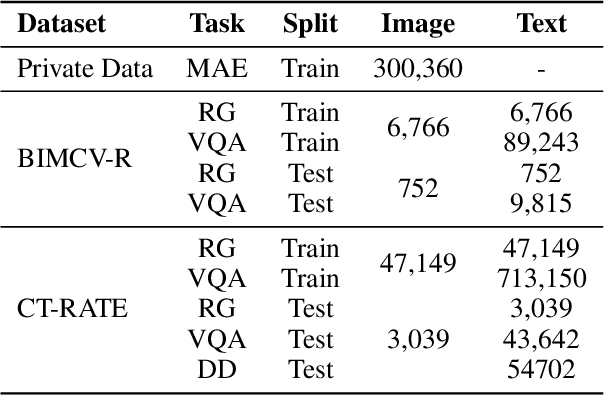

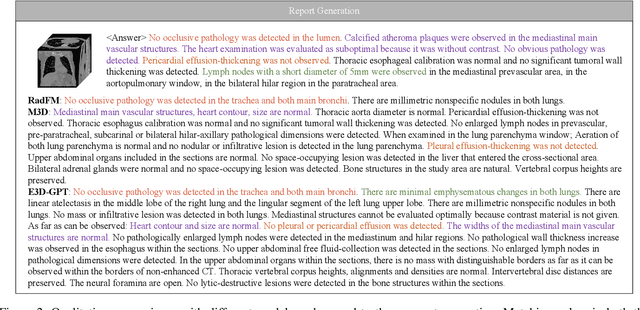
Abstract:The development of 3D medical vision-language models holds significant potential for disease diagnosis and patient treatment. However, compared to 2D medical images, 3D medical images, such as CT scans, face challenges related to limited training data and high dimension, which severely restrict the progress of 3D medical vision-language models. To address these issues, we collect a large amount of unlabeled 3D CT data and utilize self-supervised learning to construct a 3D visual foundation model for extracting 3D visual features. Then, we apply 3D spatial convolutions to aggregate and project high-level image features, reducing computational complexity while preserving spatial information. We also construct two instruction-tuning datasets based on BIMCV-R and CT-RATE to fine-tune the 3D vision-language model. Our model demonstrates superior performance compared to existing methods in report generation, visual question answering, and disease diagnosis. Code and data will be made publicly available soon.
CARZero: Cross-Attention Alignment for Radiology Zero-Shot Classification
Feb 27, 2024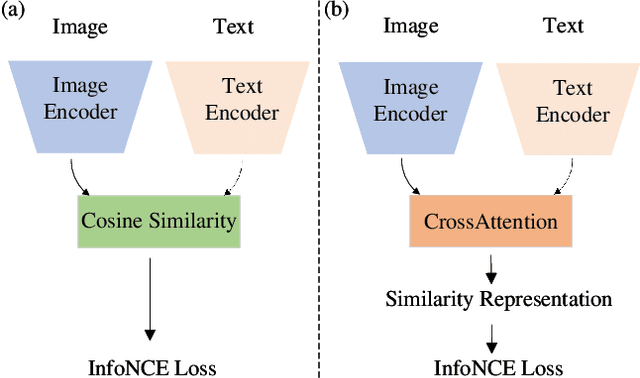

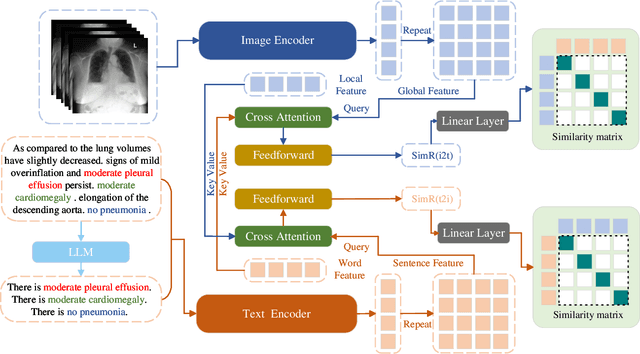
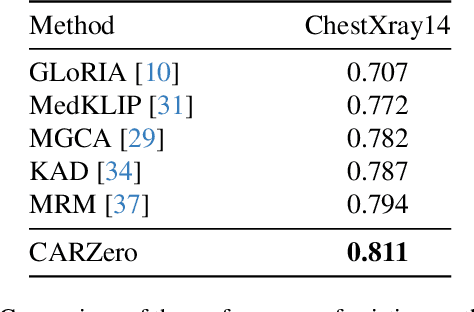
Abstract:The advancement of Zero-Shot Learning in the medical domain has been driven forward by using pre-trained models on large-scale image-text pairs, focusing on image-text alignment. However, existing methods primarily rely on cosine similarity for alignment, which may not fully capture the complex relationship between medical images and reports. To address this gap, we introduce a novel approach called Cross-Attention Alignment for Radiology Zero-Shot Classification (CARZero). Our approach innovatively leverages cross-attention mechanisms to process image and report features, creating a Similarity Representation that more accurately reflects the intricate relationships in medical semantics. This representation is then linearly projected to form an image-text similarity matrix for cross-modality alignment. Additionally, recognizing the pivotal role of prompt selection in zero-shot learning, CARZero incorporates a Large Language Model-based prompt alignment strategy. This strategy standardizes diverse diagnostic expressions into a unified format for both training and inference phases, overcoming the challenges of manual prompt design. Our approach is simple yet effective, demonstrating state-of-the-art performance in zero-shot classification on five official chest radiograph diagnostic test sets, including remarkable results on datasets with long-tail distributions of rare diseases. This achievement is attributed to our new image-text alignment strategy, which effectively addresses the complex relationship between medical images and reports.
ECAMP: Entity-centered Context-aware Medical Vision Language Pre-training
Dec 20, 2023Abstract:Despite significant advancements in medical vision-language pre-training, existing methods have largely overlooked the inherent entity-specific context within radiology reports and the complex cross-modality contextual relationships between text and images. To close this gap, we propose a novel Entity-centered Context-aware Medical Vision-language Pre-training (ECAMP) framework, which is designed to enable a more entity-centered and context-sensitive interpretation of medical data. Utilizing the recent powerful large language model, we distill entity-centered context from medical reports, which enables ECAMP to gain more effective supervision from the text modality. By further pre-training our model with carefully designed entity-aware, context-enhanced masked language modeling and context-guided super-resolution tasks, ECAMP significantly refines the interplay between text and image modalities, leading to an enhanced ability to extract entity-centered contextual features. Besides, our proposed multi-scale context fusion design also improves the semantic integration of both coarse and fine-level image representations, prompting better performance for multi-scale downstream applications. Combining these components leads to significant performance leaps over current state-of-the-art methods and establishes a new standard for cross-modality learning in medical imaging, whose effectiveness is demonstrated by our extensive experiments on various tasks including classification, segmentation, and detection across several public datasets. Code and models are available at https://github.com/ToniChopp/ECAMP.
Long-tailed multi-label classification with noisy label of thoracic diseases from chest X-ray
Nov 29, 2023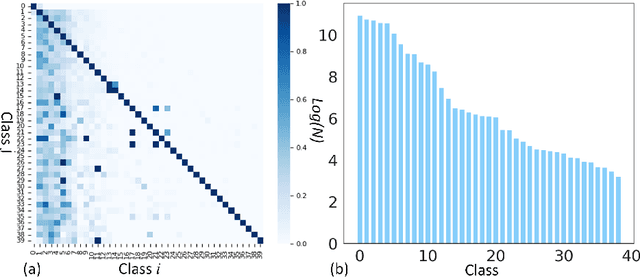

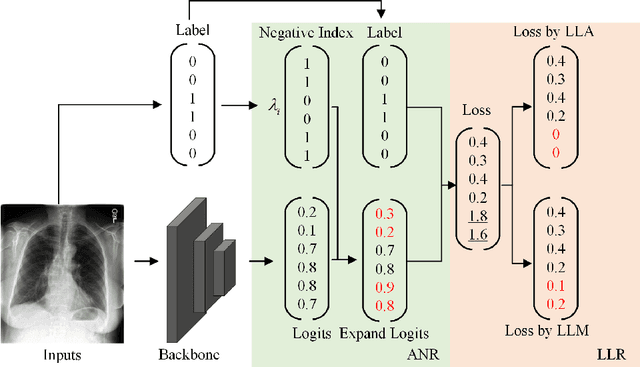

Abstract:Chest X-rays (CXR) often reveal rare diseases, demanding precise diagnosis. However, current computer-aided diagnosis (CAD) methods focus on common diseases, leading to inadequate detection of rare conditions due to the absence of comprehensive datasets. To overcome this, we present a novel benchmark for long-tailed multi-label classification in CXRs, encapsulating both common and rare thoracic diseases. Our approach includes developing the "LTML-MIMIC-CXR" dataset, an augmentation of MIMIC-CXR with 26 additional rare diseases. We propose a baseline method for this classification challenge, integrating adaptive negative regularization to address negative logits' over-suppression in tail classes, and a large loss reconsideration strategy for correcting noisy labels from automated annotations. Our evaluation on LTML-MIMIC-CXR demonstrates significant advancements in rare disease detection. This work establishes a foundation for robust CAD methods, achieving a balance in identifying a spectrum of thoracic diseases in CXRs. Access to our code and dataset is provided at:https://github.com/laihaoran/LTML-MIMIC-CXR.
Medical Exam Question Answering with Large-scale Reading Comprehension
Feb 28, 2018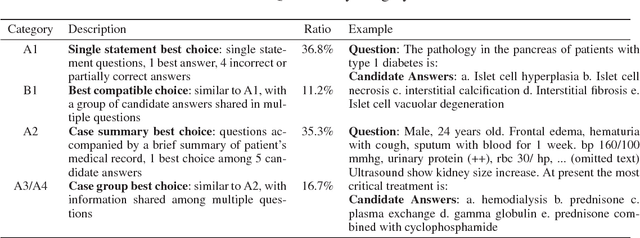

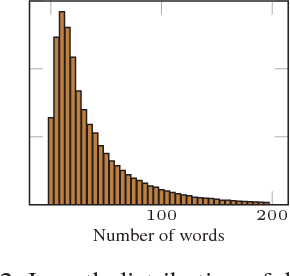

Abstract:Reading and understanding text is one important component in computer aided diagnosis in clinical medicine, also being a major research problem in the field of NLP. In this work, we introduce a question-answering task called MedQA to study answering questions in clinical medicine using knowledge in a large-scale document collection. The aim of MedQA is to answer real-world questions with large-scale reading comprehension. We propose our solution SeaReader--a modular end-to-end reading comprehension model based on LSTM networks and dual-path attention architecture. The novel dual-path attention models information flow from two perspectives and has the ability to simultaneously read individual documents and integrate information across multiple documents. In experiments our SeaReader achieved a large increase in accuracy on MedQA over competing models. Additionally, we develop a series of novel techniques to demonstrate the interpretation of the question answering process in SeaReader.
 Add to Chrome
Add to Chrome Add to Firefox
Add to Firefox Add to Edge
Add to Edge